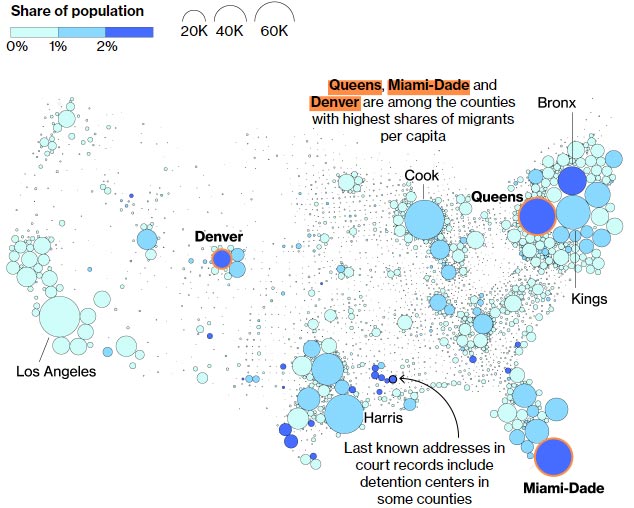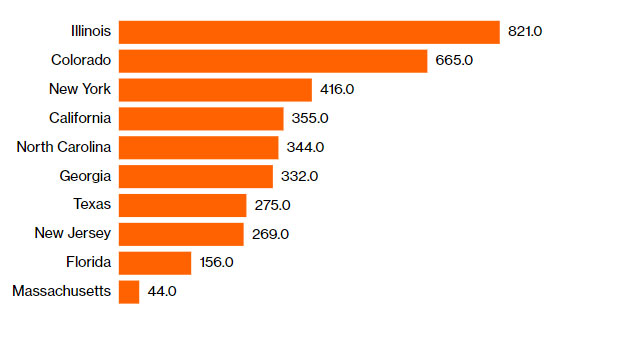
Migration Perspectives & Contextualization
Data collected during border crossings and from immigration courts reveal the recent surge of migrants to the US has more than a few nuances. While much of the angst around the impact of newly arrived migrants has focused on big cities in New York, Illinois, and Colorado, the data suggests that these states are indeed among the most affected by the surge. However, it also highlights that Texas and Florida, which have long complained about the costs of absorbing newcomers, are still among the top destinations for migrants.
New Migrants Made Up More Than 2% of People in Some Counties
Number of migrants with new immigration court cases in 2023
 Source: Department of Justice EOIR case data, released after FOIA requests by TRAC at Syracuse University
Source: Department of Justice EOIR case data, released after FOIA requests by TRAC at Syracuse University
in recent years, the number of migrants listing an address in Illinois for their immigration court cases has seen a significant increase. Data from 2023 shows that this number jumped nine-fold compared to just two years earlier. A similar trend was observed in Colorado, where the increase was seven-fold, and in New York, where it rose five times. Interestingly, these increases were even more substantial than those seen in traditionally high-immigration states like Texas and Florida.
Moreover, the data indicates that New York state experienced the highest number of migrant arrivals in 2023 on a per capita basis. Specifically, there was one migrant arrival per 100 residents of the state. Following closely behind were New Jersey and Florida with 0.9 arrivals per 100 residents. Texas and Colorado had 0.8 arrivals per 100 residents, while Illinois ranked eighth with 0.6 arrivals per 100 residents.
This surge in migrant arrivals in Illinois, Colorado, and New York reflects a broader trend of shifting migration patterns within the United States. As these states continue to attract increasing numbers of migrants for various reasons, it is essential to monitor and understand the implications of these demographic changes on local communities and immigration policies.
The Biggest Changes Are Far From the Southern Border
Percentage increase in the number of new immigration court cases from 2021 to 2023, among states with the most cases last year.

Source: Transactional Records Access Clearinghouse (TRAC) at Syracuse University
The data shows asylum seekers are dispersing throughout various regions in the United States. While many are gravitating towards urban centers, a significant number are also moving to rural areas that host thriving meat packing and agriculture industries, sectors historically reliant on migrant labor.
The accuracy of this data is somewhat compromised due to its reliance on the addresses provided by migrants to US officials overseeing their immigration court proceedings. Consequently, there are instances where these newcomers may relocate elsewhere or have yet to determine their final destinations. An audit conducted in September highlighted discrepancies in US Border Patrol records, revealing that 18% of migrant addresses were either missing, invalid, or not authentic residential locations. Nonetheless, authorities maintain that insights from immigration court cases offer a broad overview of how these individuals are distributed across the country.
Key Findings on Asylum Seeker Movement
- Asylum seekers are dispersing across the US, including both urban centers and rural areas with significant meat packing and agriculture industries.
- Data accuracy is hindered by reliance on addresses provided by migrants to US officials.
- An audit revealed discrepancies in US Border Patrol records regarding migrant addresses.
- Immigration court cases provide a general understanding of the distribution of newcomers nationwide.
In conclusion, the movement of asylum seekers within the US reflects a diverse pattern encompassing various regions and industries. Despite challenges in data accuracy, efforts are being made to track and understand the distribution of these individuals across the country.

